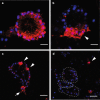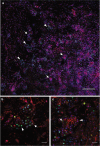The ontogeny of choanocyte chambers during metamorphosis in the demosponge Amphimedon queenslandica
- PMID: 26958337
- PMCID: PMC4782300
- DOI: 10.1186/s13227-016-0042-x
The ontogeny of choanocyte chambers during metamorphosis in the demosponge Amphimedon queenslandica
Abstract
Background: The aquiferous body plan of poriferans revolves around internal chambers comprised of choanocytes, a cell type structurally similar to choanoflagellates. These choanocyte chambers perform a range of physiological and developmental functions, including the capture of food and the generation of stem cells. Despite the increasing interest for choanocytes as sponge stem cells, there is limited knowledge on the development of choanocyte chambers. Using a combination of cell lineage tracing, antibody staining and EdU labeling, here we examine the development of choanocytes and the chambers they comprise during metamorphosis in the marine demosponge Amphimedon queenslandica.
Results: Lineage-tracing experiments show that larval epithelial cells transform into mesenchymal pluripotent stem cells, resembling archeocytes, within 24 h of initiating metamorphosis. By 36 h, some of these labeled archeocyte-like cells have differentiated into choanocytes that will form the first postlarval choanocyte chambers. Non-labeled cells also contribute to these primary choanocyte chambers, consistent with these chambers being a chimera of multiple transdifferentiated larval cell types and not the proliferation of a single choanocyte precursor. Moreover, cell proliferation assays demonstrate that, following the initial formation of choanocyte chambers, chambers grow at least partially by the proliferation of choanocytes within the chamber, although recruitment of individual cells into established chambers also appears to occur. EdU labeling of postlarvae and juveniles reveals that choanocyte chambers are the primary location of cell proliferation during metamorphosis.
Conclusion: Our results show that multiple larval cell lineages typically contribute to formation of individual choanocyte chambers at metamorphosis, contrary to previous reports in other species that show sponge choanocyte chambers form clonally. Choanocytes in postlarval and juvenile A. queenslandica chambers can also divide, with choanocyte chambers being the primary location of cell proliferation. Interestingly, the level of cell proliferation varies greatly between chambers and appears to be contingent on the size, location and developmental state of the chamber. Small chambers on the periphery of the body tend to possess more dividing cells. As choanocytes can also dedifferentiate into archeocyte-like cells, cell proliferation in chambers may not only contribute to chamber growth and self-renewal but also increase the number of pluripotent archeocytes.
Keywords: Archeocyte; Choanocyte; Choanocyte chamber; Demospongiae; Development; Evolution; Invertebrates; Ontogeny; Porifera; Stem cells.
Figures









References
-
- Simpson TL. The cell biology of sponges. New York: Springer; 1984.
-
- Hill MS, Hill AL, Lopez J, Peterson KJ, Pomponi S, Diaz MC, Thacker RW, Adamska M, Boury-Esnault N, Cárdenas P, et al. Reconstruction of family-level phylogenetic relationships within Demospongiae (Porifera) using nuclear encoded housekeeping genes. PLoS ONE. 2013;8:e50437. doi: 10.1371/journal.pone.0050437. - DOI - PMC - PubMed
LinkOut - more resources
Full Text Sources
Other Literature Sources
Research Materials

